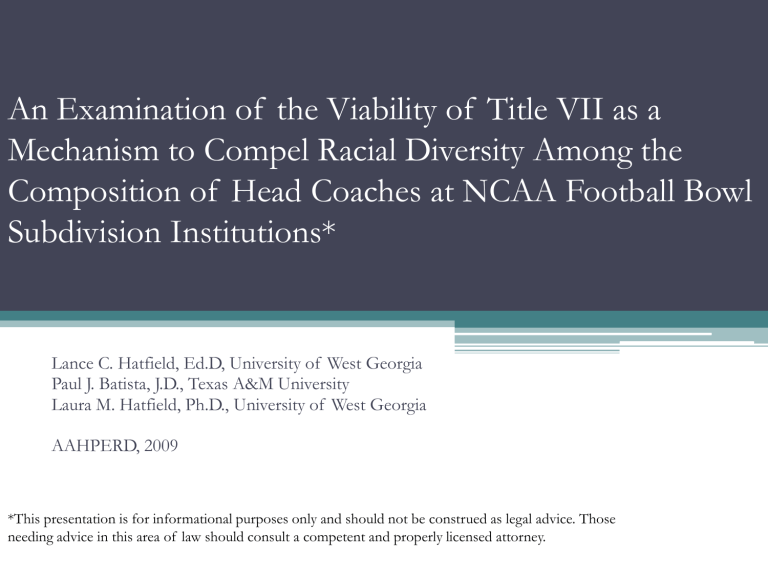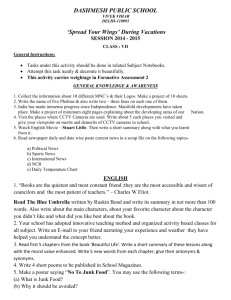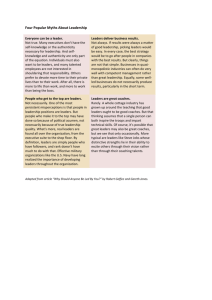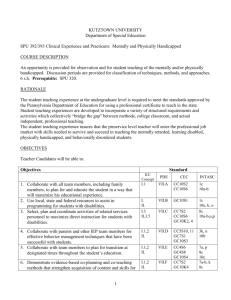AAHPERD Title VII Presentation

An Examination of the Viability of Title VII as a
Mechanism to Compel Racial Diversity Among the
Composition of Head Coaches at NCAA Football Bowl
Subdivision Institutions*
Lance C. Hatfield, Ed.D, University of West Georgia
Paul J. Batista, J.D., Texas A&M University
Laura M. Hatfield, Ph.D., University of West Georgia
AAHPERD, 2009
*This presentation is for informational purposes only and should not be construed as legal advice. Those needing advice in this area of law should consult a competent and properly licensed attorney.
Background to Study
• Compare FBS percentage to NCAA Div. I men’s basketball.
▫ ≈25% of head coaches are minority (excluding HBCUs)
▫ 8 of 12 head men’s basketball head coaches in the ACC are minority.
• Are racial minorities “underrepresented” as head coaches in major college football?
▫ Quest to last 80+ years?
▫ What is the solution?
Background to Study
Oft-Quoted Strategy to Increase Minority HCs
“The BCA is also looking seriously at initiating Title VII civil rights law suits against schools.” Dr. Richard Lapchick in the Foreward to the BCA’s Hiring Report Card,
HRC #4, 2006-2007.
“Just as Title IX has opened doors for NCAA Women’s athletics, we believe the use of Title VII may be necessary to drive this issue to the forefront.” Floyd Keith,
Executive Director of the BCA. Prepared Statement before the House
Subcommittee on Commerce, Trade, and Consumer Protection. Feb. 28, 2007.
“It (Title VII) can be a catalyst for change.” Cyrus Mehri. Quoted in,
Black Coaches Association Will Use Title VII as a Tool in Encouraging
Diversity in NCAA, U SA T ODAY , Sept. 5, 2006.
Background to Study – Title VII
• Civil Rights Act of 1964: Title VII codified at:
42 U.S.C. §§ 2000e – 20000e-17 (2000).
• § 2000e-2. (§ 703) Unlawful employment practices
(a) It shall be an unlawful employment practice for an employer –
(1) to fail or refuse to hire or to discharge any individual, otherwise discriminate against any individual…because of such individual’s race , color , religion , sex , or national origin .
Purpose of the Study
• The purpose of this study was to examine the legal strategy of utilizing Title VII of the Civil Rights Act of
1964 to compel change of the racial composition of head football coaches at NCAA FBS institutions.
Research Design & Methodology
• Qualitative, Legal Analysis
▫ Procedural guidelines for bringing suit
▫ Statutory requirements & case law precedent
▫ Comparison between Title VII & Title IX
• Descriptive Statistics
▫ Success rates for plaintiffs and defendants in cases 1998-
2006
Major Findings
• Procedural Process Obstacles
▫ Plaintiffs must first file a complaint with state/local agency or
EEOC if no state/local agency exists.
42 U.S.C. § 2000e-5(c)
▫ Plaintiff must exhaust administrative review and receive a rightto-sue letter prior to commencing an action in a court.
42 U.S.C. § 2000e-5(f)(1)
Oscar Mayer & Co. et al. v. Evans, 441 U.S. 750 (1979)
Major Findings
• Procedural Process Obstacles
▫ Plaintiff can file in either state or federal court; however, the federal court must give deference to any state level proceedings if case not instantly filed in federal court.
42 U.S.C. § 2000e-5(f)(1)
Yellow Freight Sys., Inc. v. Donnelly, 494 U.S. 820 (1989)
Major Findings
• Case Law Obstacles (Coaching Cases)
▫ Courts are extremely deferential to employers on the issue of establishing who is qualified.
Jackson v. Univ. of New Haven, 228 F. Supp.2d 156 (D. Conn. 2002)
Banks v. Pocatello Sch. Dist., 429 F. Supp.2d 1197 (D. Idaho 2006)
Amie v. El Paso Ind. Sch. Dist., LEXIS 39749 (W.D. Tex. 2007)
▫ Courts will accord employers latitude in establishing broad criteria to determine who is qualified.
Amie v. El Paso Ind. Sch. Dist., LEXIS 39749 (W.D. Tex. 2007)
Major Findings
▫ Court analysis of candidate qualifications will include juxtaposition of position postings with employers’ rationale of their hiring decisions.
Medcalf v. Univ of Penn., 71 Fed. Appx. 924 (3 rd Cir. 2003)
▫ In disparate impact cases, plaintiffs must:
Establish the qualified labor pool.
Prove that the employer’s qualification’s are unreasonable and work to exclude racial minorities or other protected classes.
Jackson v. Univ. of New Haven, 228 F. Supp.2d 156 (D. Conn. 2002)
Wynn v. Columbus Sch. Dist., 692 F. Supp. 672 (N.D. Miss. 1988)
Major Findings
▫ For discriminatory comments to be probative, they must meet two essential criteria:
They must be made by a decision maker (otherwise these comments will fall under the “stray remark” exception); and
Reliant Interest
There must be a nexus between the remarks and the adverse employment decision.
Medcalf v. Univ of Penn., 71 Fed. Appx. 924 (3 rd Cir. 2003)
Richardson v. Sugg, 448 F.3d 1046 (8 th Cir. 2006)
Major Findings – Challenges to the Efficacy of Litigation
50-50 Proposition for Winning a Title VII Action?
1998-2006 Federal Title VII Plaintiff Success Rates
• Pre-Trial Adjudication Win Rate: 1.84%
• Jury Trial Win Rate: 37.9%
• Judge Trial Win Rate: 26.7%
Raw data accessed from the Administrative Office of the U.S. Courts, available via ICPSR.
Type of discrimination alleged (e.g., race, color, etc.) not available.
Major Findings – Challenges to the Efficacy of Litigation
Reversal of District Court Holdings on Appeal
Stage
Pre-Trial
Trial
Total
Plff. Wins Below Def. Wins Below
54.3% 10.7%
41.8%
42.8%
7.5%
10.1%
See Clermont & Schwab (2004). These results are for all employment discrimination causes of action.
Major Findings – Title VII v. Title IX
• Procedural Differences
▫ Title IX investigations can commence based upon:
Complaint filed in a court by an injured individual(s)
Complaint filed with the Office for Civil Rights (OCR) by an injured individual or other interested party
▫ Title VII requires the exhaustion of administrative remedies prior to filing a lawsuit.
See Carpenter & Acosta (2005).
Major Findings – Title VII v. Title IX
• Procedural Differences
▫ Standing not an issue when filing a complaint with the
OCR in Title IX actions.
Standing is required when filing a Title IX court action.
▫ Standing is required to file a Title VII action with both the EEOC and in a court.
▫ Therefore, aggrieved individuals (e.g., coaches) do not have to be directly involved in a Title IX action.
Coaches are reticent to file Title VII actions.
See Carpenter & Acosta (2005).
Summary of Major Conclusion
• Title VII is a protracted process which tends to work against plaintiffs.
▫ Pro se plaintiffs
• Case outcomes data leads to the inference that courts are antiplaintiff in employment discrimination suits.
Summary of Major Conclusion
• Title VII not as conducive to advocacy actions as
Title IX.
• Therefore, Title VII offers limited hope to bring about a more racially balanced head coaching landscape in major college football.
Recommendations
• Injured coaches should bring suit and bring suit often.
▫ Obtain standing is the first step.
▫ BCA and the “perfect plaintiff ”.
• Encourage the hiring of minority candidates in all NCAA divisions, not just the elite level.
• Minority coaches should not refuse to interview.
Recommendations
• “Eddie Robinson” Rule
▫ Can the Association implement this?
• Court of public opinion
▫ USM & Title IX
• Potential litigation strategy
Potential Litigation Strategy
• Is an application necessary for standing to sue?
Consider the Case Law
Carmichael v. Birmingham Saw Works, 738 F.2d 1126, 1133 (11 th
Cir. 1984).
“[W]hen an employer uses such informal [hiring] methods, it has a duty to consider all those who might reasonably be interested, as well as those who have learned of the job opening and expressed an interest.”
Potential Litigation Strategy
Consider the Case Law
Wright et al. v. Stern et al., 450 F. Supp.2d 335, 368-369
(S.D.N.Y. 2006).
“Parks did not regularly post available positions…[A]ll of the named plaintiffs identified positions for which they would have applied had they been posted…A reasonable jury could accept these conclusions and find that…Parks’ subjective employment practices adversely impacted class members.”
Potential Litigation Strategy
Consider the Case Law
E.E.O.C. v. Metal Service Co., 892 F.2d 341, 348 (3 rd Cir.
1990).
“Courts have generally held that the failure to formally apply for a job opening will not bar a Title VII plaintiff from establishing a prima facie case of discriminatory hiring, as long as the plaintiff made every reasonable attempt to convey his interest in the job to the employer.”
Potential Litigation Strategy
Consider the Case Law
Morris v. Wallace Comm. College-Selma, 125 F. Supp. 1315, 1329
(S.D. Ala. 2001).
“The College cannot avoid liability for unlawful discrimination in that selection process by the simple expedient of naming athletic directors without first accepting applications. When an employer uses such informal methods [as word of mouth to identify candidates for a position] it has a duty to consider all those who might be reasonably interested, as well as those who have learned of the job opening and expressed an interest.”
(emphasis added).
Potential Litigation Strategy
• Questions
▫ What methods are being utilized by the BCA and NCAA
Men’s Coaches and Expert Football Academies to publicize and place prospective candidates’ names in front of intercollegiate presidents and ADs?
▫ Are these notifications enough to create a reasonable inference of interest on the part of those listed/named?
▫ Why is this strategy not being utilized?
Recommendations for Further Study
• Trend in major college athletics?
▫ Separate athletic associations – Joint Liability/Integrated
Enterprise Doctrine
See Lyes v. City of Riviera Bch., 166 F.3d 1332 (11 th Cir. 1999).
Recommendations for Further Study
• Consider the following quote:
“The reality is most decisions are not made by athletic directors or the presidents. There are three or four guys in the back of some restaurant that are calling the shots.”
Carey Bailey
Head Coach
Howard Univ.
See Olin Buchanan, Black Coaches Confident in Progress, R IVALS.COM
, June 10, 2007.
Recommendations for Further Study
• Predicated upon Coach Bailey’s, among other’s, statement, minorities and women should be encouraged to become more involved in the de facto power structure of college sports (i.e., become boosters).
▫ Increase graduation rates among minorities.
▫ Foster an ethos of “giving back” among former studentathletes and general student minorities.
▫ Research the salience of former s-a’s who make it to the pros v. the big dollar donors.
Recommendations for Further Study
• Ascertain if head coach-designates will become a growing trend and investigate how this will impact:
▫ Standing for potential Title VII litigation
▫ Minority coach advocacy focus




